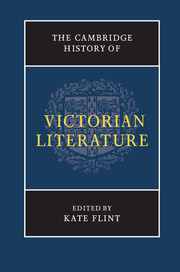Book contents
- Frontmatter
- Introduction
- PART I AUTHORS, READERS, AND PUBLISHERS
- PART II WRITING VICTORIA’s ENGLAND
- PART III MODES OF WRITING
- PART IV MATTERS OF DEBATE
- PART V SPACES OF WRITING
- PART VI VICTORIAN AFTERLIVES
- 32 1900 and the début de siècle: poetry, drama, fiction
- 33 The future of Victorian literature
- Select bibliography
- Index
33 - The future of Victorian literature
from PART VI - VICTORIAN AFTERLIVES
Published online by Cambridge University Press: 28 March 2012
- Frontmatter
- Introduction
- PART I AUTHORS, READERS, AND PUBLISHERS
- PART II WRITING VICTORIA’s ENGLAND
- PART III MODES OF WRITING
- PART IV MATTERS OF DEBATE
- PART V SPACES OF WRITING
- PART VI VICTORIAN AFTERLIVES
- 32 1900 and the début de siècle: poetry, drama, fiction
- 33 The future of Victorian literature
- Select bibliography
- Index
Summary
In May 2008 Victorian science fiction came to life as installation art in London and New York. Two enormous drills burst upwards through piers on the South Bank and in Brooklyn, the bits still rotating from the stupendous effort supposedly required to dig a transatlantic tunnel. Michel Verne, son of Jules Verne, published a story in The Strand Magazine in 1895 about a tunnel beneath the Atlantic. More than a century later, the artist Paul St George imagined the completion of such a tunnel and the construction of a Telectroscope, another Victorian technological fantasy, a never perfected machine that could transmit images along a telegraph wire. The artist installed a 37-foot long, 11-foot tall, brass and wood viewing tube in each of the cities and connected them via a video conferencing link, so that spectators, for a small fee, could wave and dance and scrawl messages to their counterparts across the pond. The massive faux-Victorian viewing tubes were only the tangible manifestations of a more elaborate fiction. On an accompanying website and blog, the artist tells the story of his (imaginary) great-grandfather, Alexander Stanhope St George, who began construction of the 3,460 mile tunnel in the 1890s but was forced to abandon the dig because of a series of disastrous mishaps. Lost from history, the project lay dormant until Paul St George ‘rediscovered’ his fictitious great-grandfather’s plans and set out to complete both the transatlantic tunnel and the Telectroscope.
- Type
- Chapter
- Information
- The Cambridge History of Victorian Literature , pp. 712 - 729Publisher: Cambridge University PressPrint publication year: 2012
- 1
- Cited by



